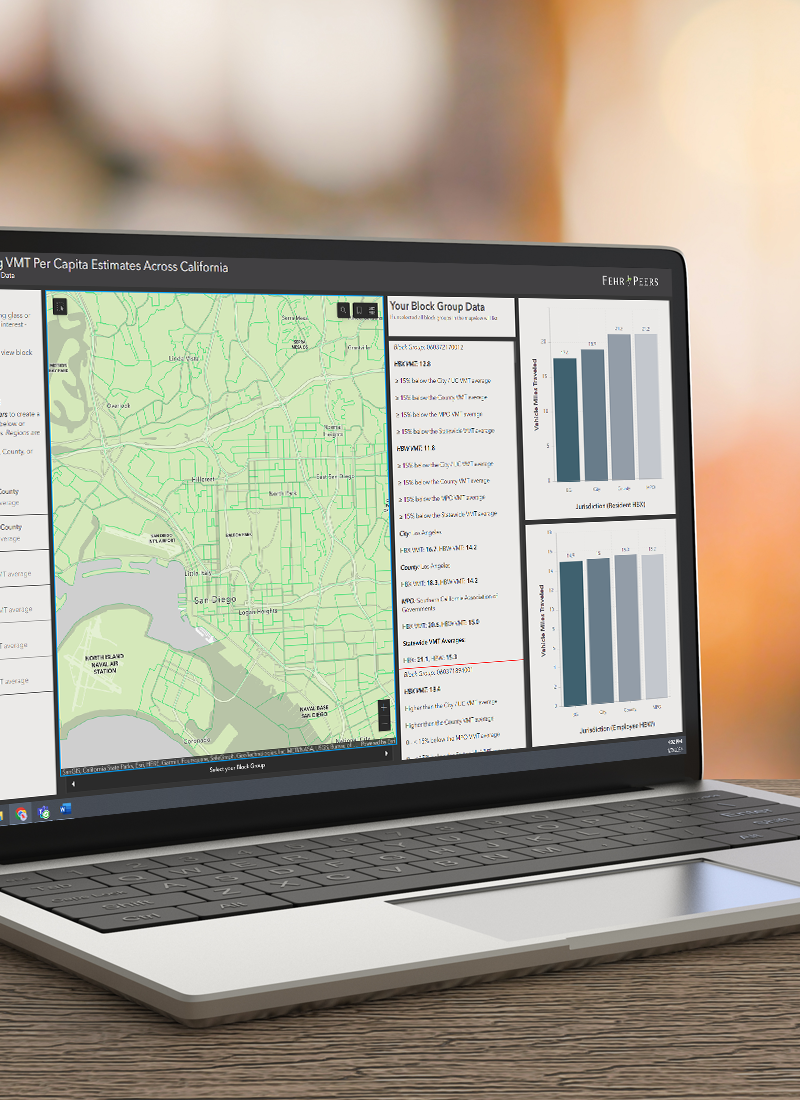California Senate Bill 743
What is California SB 743?
Senate Bill 743 (SB 743) shifts California’s approach to transportation impact analysis. Instead of focusing on congestion relief, it places the reduction of vehicle miles traveled (VMT) at the center of impact analysis.
SB 743 transforms how engineers and planners approach transportation and land use plans and projects.
As the law evolves, we evolve our methods. This shift gives communities the chance to rethink how they grow and move, and directs them towards more sustainable solutions for the future.
We help clients navigate all the complexities of CEQA and SB 743, leaning on our deep understanding of the relationship between technical decisions and the litigation risk associated with technical adequacy under CEQA and SB 743.




Supporting Sustainable Planning

Public Agencies
We’re partnered with hundreds of public agencies to help navigate SB 743 implementation and complete impact studies.
Jurisdictions across California
Whether urban, suburban, or rural, implementing SB 743 works best when it reflects the local community.
Additional Resources
- Flowcharts to identify how to navigate your project or plan through SB 743
- Quantifying GHG for local governments, communities, and project developers (CA Air Pollution Control Officers Association)
- Criteria for assessing travel models for environmental review
- Methods for verifying travel model sensitivity and quantifying highway project impacts (FHWA)
- VMT, GHG emissions, and modeling scenarios for project-level climate goal alignment (CA Air Resources Board)
- Guidance for FHWA reviewers on NEPA document development (FHWA)
- Assessment of regional GHG reduction progress, MPO challenges, best practices, and policy impacts (CA Air Resources Board)
- Handbook on analyzing on-road GHG emissions, integrating findings into planning, and evaluating VMT forecasting methods (FHWA)
- Visual example of how a highway expansion may influence short-term travel decisions
- Approaches for forecasting induced VMT for roadway capacity projects under CEQA and NEPA
- Technical guidance for estimating, forecasting, and analyzing induced VMT (Caltrans)
- Summary of how to connect academic research on induced vehicle travel to practical applications (TRB)
- White paper: Land Conservation & VMT Reduction Analysis
- White paper draft for feedback: How Housing Subsidy Programs Can Reduce VMT
- White paper: Programmatic Infill Development Incentives
- Visual comparison of VMT and GHG reduction strategies
- White paper: VMT Mitigation Through Fees, Banks, & Exchanges
- Using VMT to promote sustainability
- VMT quantification, impact assessment, and mitigation (SB743.org)
- Issues with LOS, alternative metrics, and implementation challenges
- Urban: City of Los Angeles (LADOT)
- Urban: City of San Francisco
- Urban: City of San Jose
- Suburban: Butte County (BCAG)
- Suburban: Placer County
- Rural: Mendocino County
- Rural: Tahoe (TRPA)
- Summary of agency decisions, options, and considerations
- Lexicon guide to understanding key VMT metrics and their impact
- Criteria for assessing travel models for environmental review
- Methods for verifying travel model sensitivity and quantifying highway project impacts (FHWA)
- Guidance for FHWA reviewers on NEPA document development (FHWA)
- Handbook on analyzing on-road GHG emissions, integrating findings into planning, and evaluating VMT forecasting methods (FHWA)
- Visual example of how a highway expansion may influence short-term travel decisions
- Approaches for forecasting induced VMT for roadway capacity projects under NEPA
- White paper draft for feedback: How Housing Subsidy Programs Can Reduce VMT
- Using VMT to promote sustainability
- Issues with LOS, alternative metrics, and implementation challenges
Navigating the Change
Implementation Guidance
- Flowcharts to identify how to navigate your project or plan through SB 743
- Quantifying GHG for local governments, communities, and project developers (CA Air Pollution Control Officers Association)
- Criteria for assessing travel models for environmental review
- Methods for verifying travel model sensitivity and quantifying highway project impacts (FHWA)
- VMT, GHG emissions, and modeling scenarios for project-level climate goal alignment (CA Air Resources Board)
- Guidance for FHWA reviewers on NEPA document development (FHWA)
- Assessment of regional GHG reduction progress, MPO challenges, best practices, and policy impacts (CA Air Resources Board)
- Handbook on analyzing on-road GHG emissions, integrating findings into planning, and evaluating VMT forecasting methods (FHWA)
Induced VMT
- Visual example of how a highway expansion may influence short-term travel decisions
- Approaches for forecasting induced VMT for roadway capacity projects under CEQA and NEPA
- Technical guidance for estimating, forecasting, and analyzing induced VMT (Caltrans)
- Summary of how to connect academic research on induced vehicle travel to practical applications (TRB)
Mitigation Strategies
- White paper: Land Conservation & VMT Reduction Analysis
- White paper draft for feedback: How Housing Subsidy Programs Can Reduce VMT
- White paper: Programmatic Infill Development Incentives
- Visual comparison of VMT and GHG reduction strategies
- White paper: VMT Mitigation Through Fees, Banks, & Exchanges
Case Studies
- Using VMT to promote sustainability
- VMT quantification, impact assessment, and mitigation (SB743.org)
- Issues with LOS, alternative metrics, and implementation challenges
- Urban: City of Los Angeles (LADOT)
- Urban: City of San Francisco
- Urban: City of San Jose
- Suburban: Butte County (BCAG)
- Suburban: Placer County
- Rural: Mendocino County
- Rural: Tahoe (TRPA)
General VMT Resources
- Summary of agency decisions, options, and considerations
- Lexicon guide to understanding key VMT metrics and their impact
- Criteria for assessing travel models for environmental review
- Methods for verifying travel model sensitivity and quantifying highway project impacts (FHWA)
- Guidance for FHWA reviewers on NEPA document development (FHWA)
- Handbook on analyzing on-road GHG emissions, integrating findings into planning, and evaluating VMT forecasting methods (FHWA)
- Visual example of how a highway expansion may influence short-term travel decisions
- Approaches for forecasting induced VMT for roadway capacity projects under NEPA
- White paper draft for feedback: How Housing Subsidy Programs Can Reduce VMT
- Using VMT to promote sustainability
- Issues with LOS, alternative metrics, and implementation challenges
Let’s Connect
Have questions? We’re here to help.
Ron Milam
Direct of Evolving the Status Quo
Email Me
Matt Goyne
Principal
Email Me


